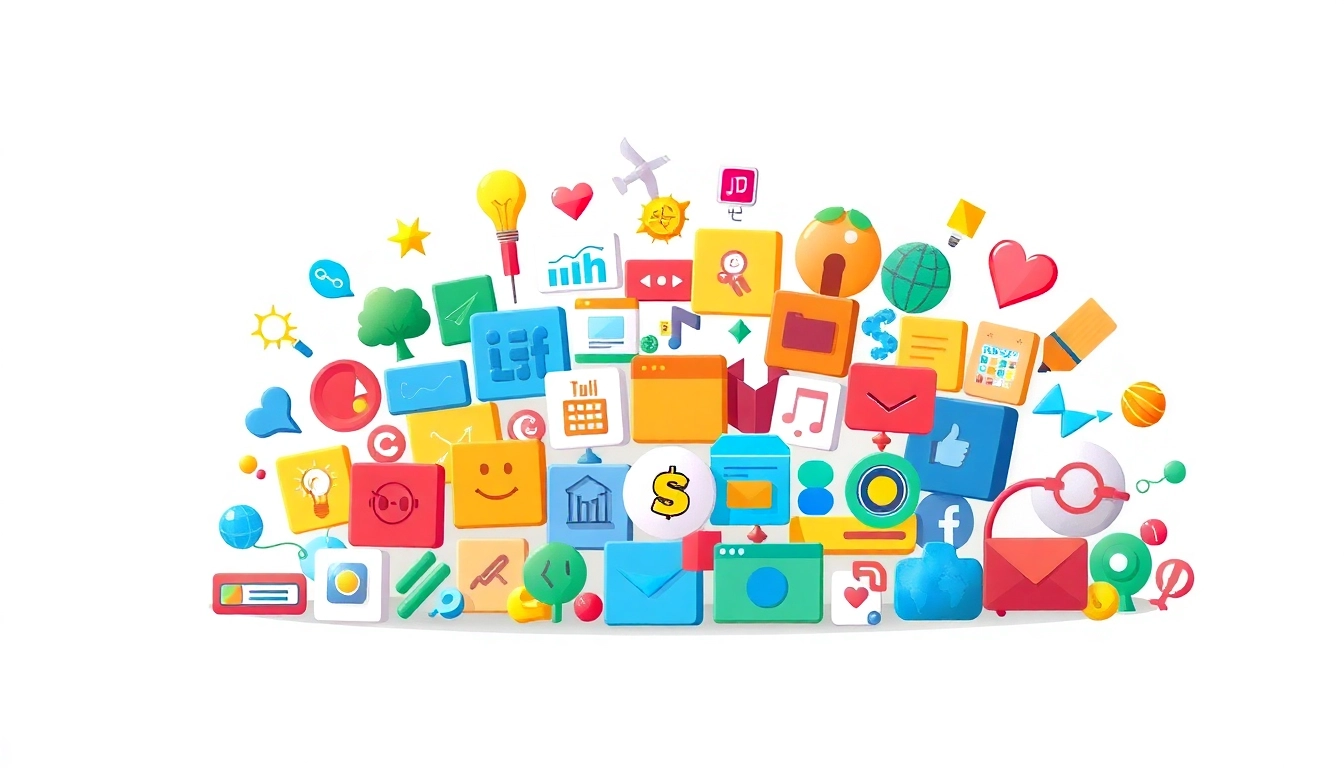Understanding Icons: Definition and Importance
Icons play a pivotal role in visual communication across various platforms, serving not just as mere decorative elements but as vital components that enhance user experience (UX). Whether you’re designing a website, crafting a mobile application, or creating printed materials, understanding icons and their significance can drastically improve clarity and engagement with your audience.
What are Icons?
Icons are graphic symbols that represent an idea, concept, or function visually. They can range from simple images or abstract shapes to more complex illustrations that convey specific meanings. Icons are utilized in numerous contexts, including user interface design, branding, and information dissemination. The essential characteristic of icons is their ability to communicate messages quickly and effectively, often transcending language barriers.
The Significance of Icons in Visual Communication
Icons are crucial for several reasons. Firstly, they enhance comprehension; users can quickly understand an action or concept without reading extensive text. Secondly, they add aesthetic value, making designs visually appealing and engaging. While icons simplify navigation and improve usability, they also help create a cohesive brand identity when utilized consistently across various platforms.
Types of Icons: A Comprehensive Overview
Icons can be categorized into various types based on their function and design style. Some common types include:
- Representative Icons: These represent real-world objects, such as a folder icon for file storage, making them relatable to users.
- Action Icons: Such icons indicate processes or actions, like a trash bin for delete or a magnifying glass for search, directing users efficiently through designs.
- Symbolic Icons: Often abstract, these communicate broader concepts—like a heart for love or a globe for global services—where the representation is more metaphorical than literal.
- Decorative Icons: Used primarily for aesthetic purposes, these icons enhance visual interest without conveying specific functions.
Choosing the Right Icons for Your Project
Determining Your Needs and Goals
Before selecting icons for your project, it’s essential to clearly define your objectives. Are you aiming to enhance usability, convey information, or establish a brand identity? Understanding the context of usage can guide the selection process. For instance, if you are working on a health-related application, using universally recognized symbols like a stethoscope or a medical cross can enhance user trust and understanding.
Finding Icons: Resources and Tools
There are numerous platforms available for sourcing icons, each offering unique styles and formats. Here are some popular resources:
- Flaticon: Offers a vast collection of icons in various formats like PNG, SVG, and EPS. It’s ideal for designers seeking flexibility in file types.
- Icons8: Provides free icons across multiple themes and categories, accompanied by tools for custom design.
- Noun Project: Known for its vast array of user-generated icons, this platform allows for unique and creative options.
Assessing Quality and Style Consistency
When selecting icons, quality and style consistency are vital. Icons should complement each other visually and belong to a unified design language. Pay attention to factors such as line weight, color palette, and overall style. Icons that clash can lead to confusion and detract from the user experience. Always opt for vector formats when possible, as they maintain quality at any scale.
Creating Custom Icons: Best Practices
Design Principles for Effective Icons
When designing custom icons, adhering to certain principles is crucial for effectiveness:
- Simplicity: Effective icons communicate their message clearly and immediately. Avoid overly complicated designs that require explanation.
- Scalability: Icons must be recognizable at various sizes. Ensure they remain effective when scaled down for mobile devices or magnified for larger displays.
- Contextual Relevance: Icons should relate to their purpose. For example, a camera icon ought to represent photography or media-related actions.
Using Design Tools to Create Custom Icons
Several design tools facilitate the creation of custom icons. Programs such as Adobe Illustrator and Sketch offer extensive features tailored for icon design. Online platforms like Canva also provide user-friendly interfaces for quick designs, though they may have limitations in comparison to professional software. When using these tools, ensure that you export your icons in various formats (SVG, PNG, and EPS) for versatility.
Testing Responsiveness Across Platforms
The visual impact of an icon can vary significantly across different devices and screen sizes. It’s vital to test icons within the contexts they will be used. Tools like BrowserStack or Responsinator can simulate how icons appear on various devices, ensuring that your designs remain effective regardless of user interface.
Implementing Icons Efficiently in Your Designs
Optimizing Icons for Web and Mobile
Optimizing icons is key to ensuring quick load times and a seamless user experience. Use vector formats whenever possible since they are typically smaller in file size and can be scaled without losing quality. Techniques include:
- SVG Compression: Compress SVG files to reduce their size further without compromising quality. Various online tools are available for this purpose.
- Sprite Sheets: Combine multiple icons into a single sprite sheet to cut down on HTTP requests during page loading.
Techniques for Reducing Load Time with Icons
Implementing icons efficiently can significantly improve site performance. Here are effective strategies:
- Lazy Loading: Load icons only when they are in the user’s view to reduce initial load time.
- Utilize Web Fonts: Consider using icon fonts (like Font Awesome) to keep icon usage lightweight and scalable.
Maintaining Accessibility and Usability
Accessibility is critical in design. Icons must be understandable to all users, including those with disabilities. This can be achieved by:
- Providing Alt Text: Ensure that every icon has accompanying descriptive alt text to assist screen readers.
- Contrast and Visibility: Use colors that provide sufficient contrast against backgrounds, making icons stand out for users with visual impairments.
Measuring the Impact of Icons on Engagement
Analyzing User Interaction with Icons
Understanding user interaction with icons can guide future design choices. Utilizing analytics tools allows designers to track how users engage with icons, for example, how frequently they click on specific icons. Heatmap tools like Hotjar or Crazy Egg can visually represent user behavior, showing which icons attract more attention.
Metrics to Track Icon Effectiveness
When assessing the effectiveness of icons, consider the following metrics:
- Click-Through Rate (CTR): Measure how often users click on icons compared to views to understand their effectiveness.
- Time on Page: An increase in time spent on pages with specific icons may indicate enhanced engagement driven by effective visual cues.
Case Studies: Successful Use of Icons in Design
Exploring successful applications of iconography can provide insight and inspiration for your projects. For instance, Airbnb utilizes icons effectively within its user interface to signify actions like searching, booking, and navigating, resulting in an intuitive customer experience. Similarly, Spotify uses icons to represent playlists, artists, and albums, enhancing discoverability and engagement within its platform.



